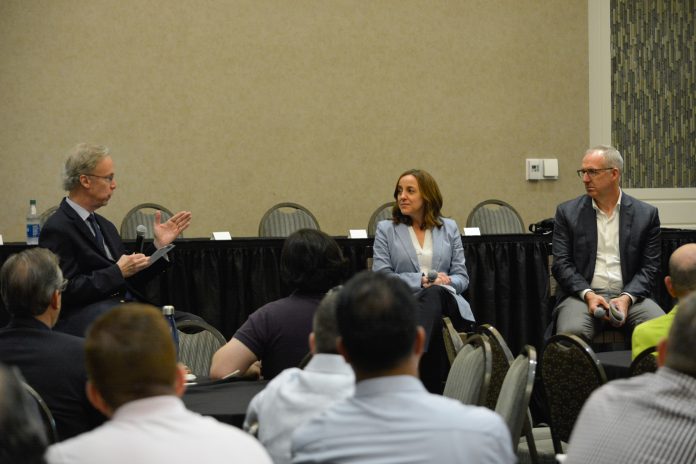By Meghan Rominger
Sports Capital Journalism Program, IUPUI
After forming in October 2021 and working toward resolutions and suggestions, the NCAA Division I Transformation Committee is clear about its priority moving forward: expanding and enhancing the student-athlete experience in whatever ways possible.
The committee’s Co-Chairs – Ohio University Athletics Director Julie Cromer and Southeastern Conference Commissioner Greg Sankey – delivered remarks at Thursday’s keynote luncheon, describing the committee’s work so far and its main takeaways from months of conversation.
“We’ve been talking about the best ways to support student-athletes and their challenges today and their challenges going forward,” Cromer said.
“We’ve been talking about decentralizing roles so that we can be more responsive as new issues arise and address them… We’ve talked about a more responsive and a more efficient enforcement system. And then frankly, we’ve talked about the future of Division I and whether or not we can sustain a growing Division I in the way that we’re structured now.”

Thursday’s remarks preceded one of the Transformations Committee’s first set of recommendations to the NCAA Division I Board of Directors. The NCAA announced the Transformation Committee had agreed on transfer portal and infractions improvements and had forwarded those recommendations to the board of directors for review and approval.
According to the release, “the [NCAA Division I Board of Directors] will review these recommendations at its June 30 meeting. If it supports them, it will send them to the Division I Council for feedback during that group’s July 20 meeting. The board’s vote to approve the recommendations would occur at its Aug. 3 meeting.”
Cromer and Sankey discussed several key issues Thursday, covering topics from name, image and likeness (NIL) and the transfer portal to sports gambling and its effects on student-athletes’ mental health. The Co-Chairs noted the committee hasn’t yet delivered much tangible progress, as much of its energy is focused more on the process of transformation than the outcomes.
“The first time we talked about this we asked ourselves ‘Does the Board of Directors, who is the governing group, who appointed us to this work, the Division I Transformation Committee – do they know what they’ve asked?” Cromer said. “‘And do they really mean transformation, and transformation with a capital T? Or transformation just to get us through to the next day?’”
One of the most prominent issues facing intercollegiate athletics is NIL, and Sankey and Cromer both echoed the frustrations and questions that surround NIL deals. But the Transformation Committee won’t be specifically focusing on NIL-related issues as it works to make recommendations for the NCAA.
“Name, image and likeness was actually retained by the Division I Board of Directors,” Sankey said. “So we’ve spent relatively little time on that topic because [the Division I Board of Directors] was the working group that’s appointed. And we know what’s happening, and we’re attentive to it. But that’s not at the top of our list.”
Even if the Transformation Committee did have NIL oversight, Sankey noted that legislative change to NIL isn’t a top priority for an already-overloaded Congress.
“There are enormous issues facing Congress, enormous issues. And as a citizen, if I look at the scale and scope of those issues, name, image and likeness comes in as kind of ‘Wow, that doesn’t seem that big of a deal,’” Sankey said.
The Co-Chairs also discussed other pressing issues like sports gambling and its detrimental effects on student-athletes.
“Imagine being at maybe not having the maturity level to manage the flow of the economy, the pressures of academic performance and pressures of athletic expectations, and then add on to it the social media pressure that we’ve seen arise around sports gambling,” Sankey explained.
“As a society, if we are not open and attentive to the reality being created around [student-athletes’] lives and sports gambling, we are abdicating our responsibility.”

Similar to NIL, the Transformation Committee wasn’t initially tasked with addressing issues related to the transfer portal. But with an uptick in transfers and commentary about the portal’s rules, the committee stepped in to attempt to stem the chaos.
“We actually spent a lot of time in the last two days, relative to the oversight of transfers, acknowledging it’s a new day and the type of control that existed before was not going to be reasserted,” Sankey said.
Much of the focus of the recommendations delivered to the Division I Board of Directors on Thursday involve “[stabilizing] the transfer environment.” The committee’s transfer recommendations include suggestions such as “additional accountability for schools that receive transfer student-athletes and [providing] student-athletes with a window of time to enter the Transfer Portal each year in order to be eligible to compete in the following year. Some of the changes to the infractions process would include incentivizing cooperation of all parties, additional investigative tools and more flexibility within confidentiality rules.”
Despite the exhaustive process and lack of deliverables thus far, the Transformation Committee has proved valuable by giving its members the opportunity proactively address problems.
“The opportunity of this committee is to get in front of what’s coming next,” Cromer said. “And that’s been a critical focus that gets lost a little bit in the stories..
“Now is a time where we have to turn our thinking upside down. We have to learn these lessons and NIL has painfully taught us in some cases, and be ready to be responsive.”
As the committee continues to work on the most pressing issues in college sports, it will be measuring its success through its ability to optimize the student-athlete experience from every possible angle.
“[The Transformation Committee] is about our student-athletes, and about the expansion and extension of those opportunities for them both on my campus and throughout the division. So to me, this enterprise is about them,” Cromer said.
“College athletics can build into young people’s lives even in these vastly different economic situations,” Sankey added. “And we want to make sure those opportunities continue for years to come, for decades to come.”





